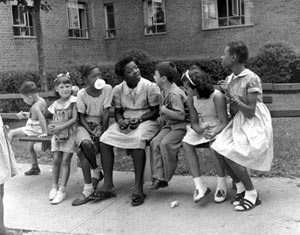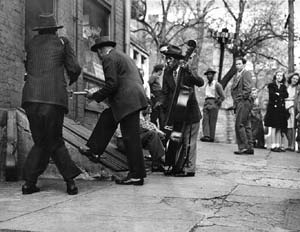Joe Schwartz’s Historical Photos Artfully Documented American Poverty
BY GLEN STARKEY
Joe Schwartz’s Atascadero house is a treasure-trove of ethnic art. Dozens of African and Asian cultures are represented in the cluttered, plant-filled space. And photographs–hundreds of them–are scattered throughout. They're hanging on walls, piled on tables, stacked against furniture, spilling out of boxes.
The milieu represents a lifetime of embracing peoples of all races, of recording significant events in American history. On one wall hangs a portrait of jazz greats Sarah Vaughan, Louis Armstrong, and Billie Holiday that Schwartz snapped at Club Oasis in the 1950s. On another wall soldiers sweep the countryside of Iwo Jima during World War II. And throughout his home hang dozens of urban scenes–children playing, women working, men out of work.
Now Schwartz’s life’s work is being compiled into a handsome coffee-table book, "Folk Photography: Poems I Have Never Written," which is being published locally and should hit bookstores next month.
As photography books go, this one's a whopper. It contains 335 images–perhaps a new record for a single photographer presented in one volume.
"I never made a living in photography," said Schwartz recently. "That's the point of this book; I'm just coming out. I've never tried to commercialize my images."
Suddenly Schwartz has found himself at the center of a maelstrom. Now that his work has been "rediscovered," he's fielding calls from curators, exhibition promoters, and gallery owners. Schwartz has arrived, and everyone agrees his work has both artistic and historical merit.
Schwartz, 86, is a compact man with long, white, ponytailed hair and a neatly trimmed beard. Despite his age he recalls vividly his youthful beginnings as a New York street photographer.
"When I started I was about 19. I had been interested in art in high school, so when I got my first camera I started taking photos of, oh, strange things. I had the idea to use them to copy into my art. At that time we were taught to gather materials from magazines and whatnot to use in art. My thinking was to get my own material to work up art ideas. Those first photographs weren't very successful, mainly because I couldn't operate the camera very well."
Despite his lack of expertise, willing photographers were hard to come by in those days, so when the Citizens’ Civic Affairs Committee learned of a young neighborhood boy–white and Jewish–he was immediately invited to join up and help document the social injustices that plagued the minority areas of New York.
"I met a number of black people there. They welcomed help from whites. When they heard I had a camera, they asked me to take pictures to document urban problems such as lack of housing. That was the beginning of my taking pictures of the urban area."
From there Schwartz found himself working for the Photography League, which was also bringing social justice to the community by documenting its problems.
"I never thought the pictures would become important to history," said Schwartz. "I always considered them interesting as works of art, so to speak, compositionally something to be engaged by, sort of a practical type of art that would bring out issues like the need for better playgrounds, better housing, jobs for people–a wish list of social issues. At that time the issue of lynching was very big. And a number of the people from the neighborhoods had gone to civil rights marches. We'd had our own civil rights marches in the neighborhoods."
Schwartz’s friendships with black Americans didn't go unpunished. On more than one occasion he was accosted by racist neighborhood ruffians who didn't approve of his ideology. In one instance, while walking by a pool hall with a black lady friend, Schwartz was confronted by a group of young white men.
"‘Look what's here,’ said one of the men, then three or four others came from the back of the pool hall and stopped us on the sidewalk," recalled Schwartz. "I felt there would be a fight, but Eunice was with me and she kept her hand on my shoulder. One fellow spit right in my eye. I started back, and since I was a wrestler I thought about pulling his feet our from under him, but she grabbed me and pulled me away from them."
For the most part, Schwartz preferred to work unbeknownst to his subjects. He walked through the neighborhoods snapping pictures of people at work and play, recording the chronic poverty that plagued many areas of New York at that time.
"Sometimes I was a little frightened. I thought something might happen. But I got along well in the neighborhood," said Schwartz. "One of my interests was in showing that people did get along with and talk to each other. That's why I think I have the largest collection of interracial photographs."
In many of Schwartz’s photographs, black, white, and Hispanic children play side by side. His work clearly demonstrated that people of various races could get along. Does he think there's more work to be done?
"Oh my goodness yes!" exclaimed Schwartz. "I know we've come a long way, no question about it. Unfortunately, social justice hasn't come far enough. There have been some advances economically–there are better jobs, more opportunities. But there are also still a lot of homeless people around."
Why did Schwartz spend a lifetime chronicling inner-city life with no financial reward expected? He explains it best in the text of his book: "To illustrate and circulate the love for humanity I so deeply felt became a mission, a driving force, the essence of a recording technique I call ‘Folk Photography.’ "
Schwartz’s deep love for all peoples comes across loud and clear. His work is still a call to arms, a reminder of the power of one person, one unblinking eye unafraid to look long and hard at the real America, one voice crying out, "We can do better; we must do better." Æ
Glen Starkey knows it takes a rainbow of colors to make a tapestry.